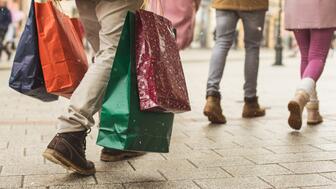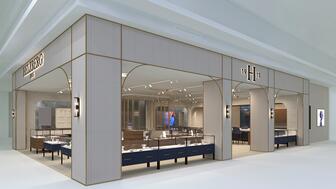The couple pleaded guilty to concealing at least $127 million in cash transactions at its precious metals businesses.
The History Behind … eye miniatures
In this new monthly feature, National Jeweler editors delve into the when, where and why of antique jewelry. August’s focus is on eye miniatures, which first became popular in the 1770s.

New York--People generally have one of two reactions when they see an eye miniature staring back at them.
“People either love them or think they are just beautiful, or people think they are creepy,” says Cathy Gordon, an antique jewelry collector and a co-author of Miriam Haskell Jewelry. “People will see them and say, ‘That is very strange.’”
Eye miniatures first began appearing in artists’ logbooks in the 1770s and retained their popularity for nearly 100 years.
In this second installment of The History Behind … , National Jeweler explores the when, where and why of eye miniatures with Gordon, who supports her antique jewelry collecting “habit” by working at Google.
What are eye miniatures? Members of the upper class, first in France then in the U.K., commissioned artists to paint portraits of a loved one’s eye only and had them set into brooches, pendants or rings, sometimes surrounded by gemstones.
Eye miniatures also were put onto toothpick cases and patch boxes (when eye miniatures were popular, many members of the upper class carried small decals with them, which sometimes were used to hide smallpox scars), Gordon says.
These pieces also are known as miniature eye portraits or “Lover’s Eye” jewelry, though Gordon notes the latter is a misnomer, as these portraits weren’t always necessarily of one’s lover. They could depict the eye of a family member or someone else close to the wearer.
When were they popular? The earliest eye miniatures recorded in artists’ log books surfaced in the 1770s and their popularity continued until the 1850s, ceasing as photography became more widespread and the public’s fascination with these eye-only paintings began to wane. “It was a fad, to some extent,” Gordon says.
She adds that the eye miniature did enjoy a very brief revival during the Arts and Crafts movement (about 1880 to 1930), as she has a miniature of a man’s eye dated 1903 in her collection.
Why did people wear eye miniatures? Part of the broader category of sentimental jewelry, the wealthy wore eye miniatures to emphasize friendships or alliances, ease the absence of a loved one who was far away and serve as a reminder of those who had died.
Eye miniature mourning pieces are recognizable by engraved and dated inscriptions; the eye surrounded by clouds (signifying a passage into heaven) or by black or white enamel; symbols of mourning
What materials were used for these pieces? Here’s where eye miniatures pose a problem for collectors today: they typically were painted on either velum or Asian elephant ivory.
Because of federal ban on the commercial trade of elephant ivory, Gordon says it is extremely difficult to import eye miniatures painted on ivory into the United States today, even when there is appropriate certification and engraved dates on the piece proving it is an antique.
(According to the Jewelers Vigilance Committee, pieces that existed in the U.S. prior to the ban, which took effect in April, may be sold across state lines except in New York and New Jersey, which have banned the sale of elephant ivory. Under these state laws, antiques comprised of less than 20 percent elephant ivory can be sold but it requires the proper permit and proof of provenance.)
Pearls were the most commonly used stone for eye miniatures. Garnets and amethysts also were popular, as were coral and turquoise. Diamonds were used but rarely, Gordon says.
How much are eye miniatures worth? Retail prices range from $2,500 for a more simple miniature to $10,000 for pieces that have more sophisticated portraits and/or more gemstones.
How can a retailer add eye miniatures to their antique jewelry offerings? Given the complex laws surrounding ivory and the existence of fakes, Gordon gives advice for retailers that is good to follow across all product categories: find a trusted supplier.
Two Gordon recommends are Lenore Dailey and The Three Graces.
“There are many, many fakes out there,” she cautions.
She says some are portraits that have been generated on very high-quality, modern printers while others were cut out from full-sized portraits and remounted falsely as eye miniatures. One word of advice: if there’s a nose, it’s an indication that it’s probably not a genuine miniature but, rather, was part of a larger portrait at one time.
The History Behind … is a new monthly feature for National Jeweler that aims to educate readers on antique jewelry. The September feature will focus on Georgian-era mourning jewelry.
The Latest

Consumers shared concerns about prices, inflation, tariffs, trade, and politics in the survey’s write-in response section.

In February 2026, the auction house will move its headquarters to the former Steinway Hall, a neoclassical landmark on Billionaires’ Row.

How Jewelers of America’s 20 Under 40 are leading to ensure a brighter future for the jewelry industry.

The new show will take place Jan. 23-25, 2026.


The former BHP Billiton leader and Gemfields chairman is remembered for his influential leadership throughout his 50-year mining career.

The LVMH-owned brand has partnered with the costume design union to revamp its award for 2026.

Roseco’s 704-page catalog showcases new lab-grown diamonds, findings, tools & more—available in print or interactive digital editions.

The luxury titan inked a deal to acquire an initial minority stake in the jewelry manufacturer with a pathway to full ownership by 2032.

The company’s curation of unsigned vintage and estate jewelry debuted at the Bloomingdale’s in Costa Mesa, California.

In the recent multi-shipment seizure, CBP also found counterfeit Audemars Piguet, Moncler, and Chrome Hearts items.

Helzberg’s Chief Retail Officer Mitch Maggart shared details about its tests of a new store concept rooted in an elevated luxury experience.

Jewelers of America execs and National Jeweler editors discuss tariffs, the sky-high gold price, and the engagement that broke the internet.

The luxury goods company said founder Ippolita Rostagno will remain at the brand’s helm.

Laura Burdese, who joined the Italian luxury brand in 2022, will take on the role in July.

The National Jeweler editors revisit the most noteworthy industry happenings and design trends from 2025.

Need a gift for the cat lover who has everything? Look no further than our latest Piece of the Week.

It purchased the “Grosse Pièce,” an ultra-complicated Audemars Piguet pocket watch from the ‘20s, for a record-breaking price at Sotheby’s.

The lab-grown diamond grower now offers custom engagement and fashion jewelry through its Kira Custom Lab Jewelry service.

Chandler got his start at Michelson Jewelers and has served as DCA president and CEO since 2001. He will retire at the end of the month.

The boutique is slated to open this week inside Terminal 8, offering pre-owned Rolex watches and more to international travelers.

Sponsored by Digital Monitoring Products

The special-edition egg pendant ingested in a New Zealand jewelry store was recovered after a six-day wait.

Associate Editor Natalie Francisco plays favorites with Piece of the Week, selecting a standout piece of jewelry from each month of 2025.

The “Love and Desire” campaign is inspired by the magic that follows when one’s heart leads the way, said the brand.

Two awardees will receive free tuition for an educational course at the Swiss lab, with flights and lodging included.

Berta de Pablos-Barbier will replace Alexander Lacik at the start of January, two months earlier than expected.


























